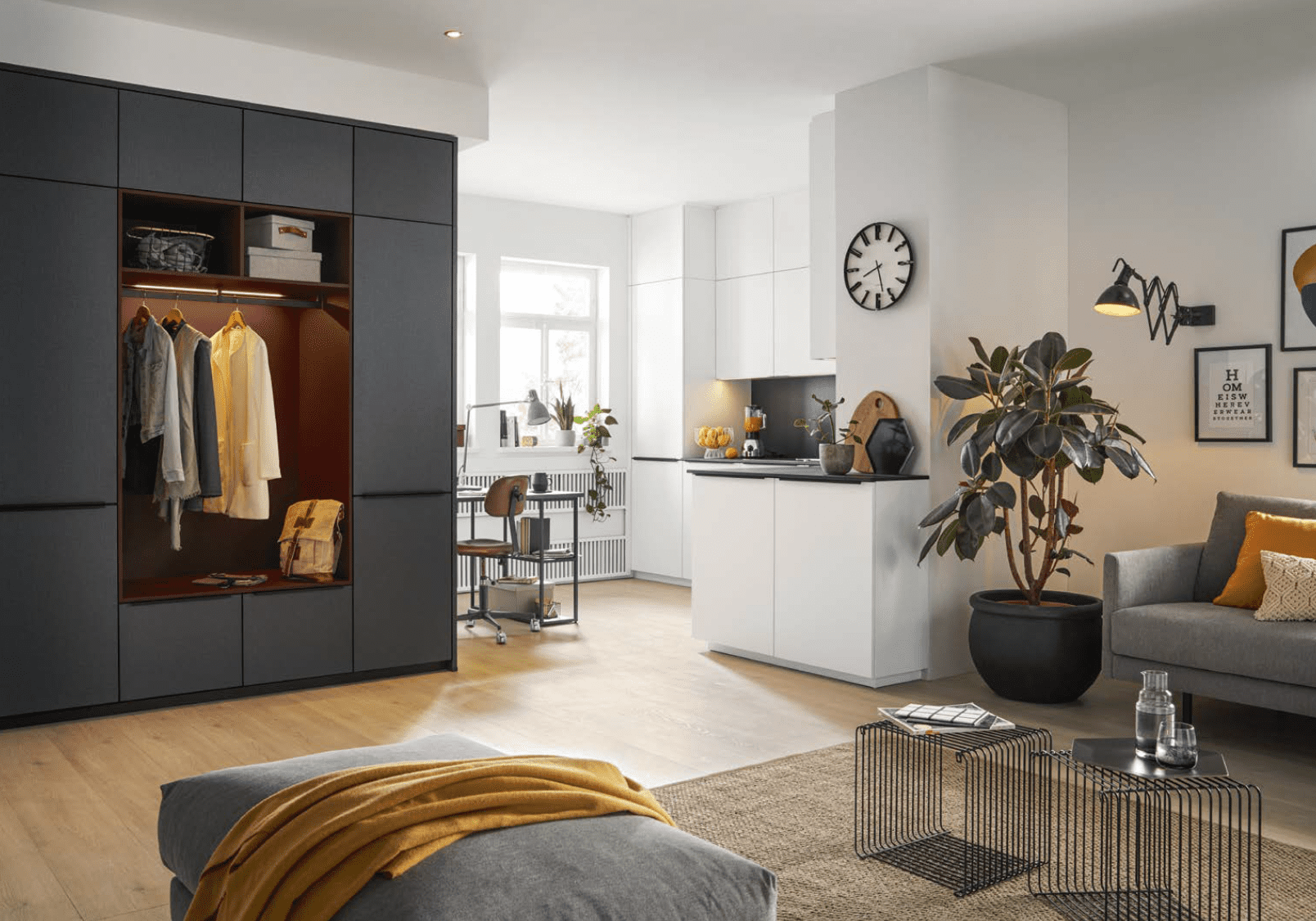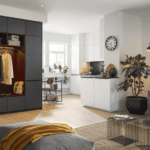Which Kitchen Layout Will Work Best For Me?

80
SHARES
Which Kitchen Layout Will Work For Me?
Designing your kitchen layout is the most important factor in ensuring a practical and functional space. Large or small, spacious or cramped, thinking about the layout will make all the difference in helping you to get the most out of your kitchen. Of course, there is a lot more to layout than just placing boxes in spaces: ergonomics has a huge role to play as well. Getting the correct height, ensuring enough space to move around, placement of appliances and ease of use are all going to factor in how enjoyable the space is to work in.

Whilst the most likely thing to determine your kitchen layout is the floorplan of your home, you can always optimise the area to work for you better. This article will showcase the most common kitchen layouts, with tips to help you do just that.
Let’s Talk Ergonomics
Before exploring layouts let’s talk ergonomics, which forms the basis of great kitchen design. Ergonomics is the science of designing the environment to fit the people that use them, not the people to fit the environment.
The Work Triangle
The concept of the work triangle was devised in the 1920’s as the principle measure of efficiency in a residential kitchen. The triangle creates a clear path between the area for food preparation (hob/ oven), food storage area (fridge/ freezer) and the cleaning area (sink).
The Principles of the Kitchen Work Triangle:
• The length of each triangle leg is between 1.2 and 2.7m
• The combined length of the three legs should be between 4m and 7.9m
• There should not be any appliances or cabinetry intersecting any of the legs of the triangle
• There should not be any major traffic through the triangle
For maximum kitchen efficiency and usability, the basic guidelines* below should be applied:
• Entry doors to the kitchen should be at least 812mm wide
• An entry door should not interfere with the safe operation of any appliances, and appliance doors should not interfere with one another
• The length of work aisles should be at least 1060mm for single cook kitchens, and 1220mm for multiple cook kitchens
• Walkways should be at least 915mm wide
• In a seating area where there is no traffic behind the seat, a clear walkway of 915mm should be allowed from the table or counter edge to the edge behind it.
• Seating should be a minimum of 610mm wide for each person. Allow a 460mm leg clearance at a table that is 760mm high; 380mm clearance at a kitchen counter (914mm high); and 305mm at bar counter (1066mm high).
• If there is only one sink, it should be located next to or across from the stove top and fridge.
• A sink should be flanked by a minimum 610mm landing area, with 460mm on either side.
• A primary work surface of at least 760mm wide and 600mm deep should be next to the sink
• A dishwasher should be placed within 900mm from a sink
• There should be a landing space of at least 380mm next to the handle side of the fridge or one no more than 1200mm opposite the fridge
• The cooking surface should have minimum landing areas of 300mm on the one side and 380mm on the other side.
• There should be a minimum of 600mm between the cooking surface and the non-combustible surface above it.
• Provide a cooking ventilation system above all cooking surface appliances.
• Do not locate the cooking surface under an operable window and provide a fire extinguisher near the kitchen’s exit, away from cooking equipment.
• Microwave ovens should be placed based on the user’s requirements, with 75mm below shoulder height being ideal.
• Provide a landing area of at least 380mm above, below or next to the microwave oven.
• Provide a landing area of at least 380mm next to the oven or one no more than 1200mm opposite the oven.
• Landing space required for adjacent appliances may be combined by taking the greater requirement and adding 300mm.
• A total of 4000mm countertop space at 600mm deep, with 380mm high clearance, is required to accommodate all storage, preparation, landing and work areas.
• In addition to general lighting, each work surface should be well lit by appropriate task lighting.
*From the guidelines set out by the National Kitchen and Bath Association
• The length of each triangle leg is between 1.2 and 2.7m
• The combined length of the three legs should be between 4m and 7.9m
• There should not be any appliances or cabinetry intersecting any of the legs of the triangle
• There should not be any major traffic through the triangle
Click For Full Guidelines
For maximum kitchen efficiency and usability, the basic guidelines* below should be applied:
• Entry doors to the kitchen should be at least 812mm wide
• An entry door should not interfere with the safe operation of any appliances, and appliance doors should not interfere with one another
• The length of work aisles should be at least 1060mm for single cook kitchens, and 1220mm for multiple cook kitchens
• Walkways should be at least 915mm wide
• In a seating area where there is no traffic behind the seat, a clear walkway of 915mm should be allowed from the table or counter edge to the edge behind it.
• Seating should be a minimum of 610mm wide for each person. Allow a 460mm leg clearance at a table that is 760mm high; 380mm clearance at a kitchen counter (914mm high); and 305mm at bar counter (1066mm high).
• If there is only one sink, it should be located next to or across from the stove top and fridge.
• A sink should be flanked by a minimum 610mm landing area, with 460mm on either side.
• A primary work surface of at least 760mm wide and 600mm deep should be next to the sink
• A dishwasher should be placed within 900mm from a sink
• There should be a landing space of at least 380mm next to the handle side of the fridge or one no more than 1200mm opposite the fridge
• The cooking surface should have minimum landing areas of 300mm on the one side and 380mm on the other side.
• There should be a minimum of 600mm between the cooking surface and the non-combustible surface above it.
• Provide a cooking ventilation system above all cooking surface appliances.
• Do not locate the cooking surface under an operable window and provide a fire extinguisher near the kitchen’s exit, away from cooking equipment.
• Microwave ovens should be placed based on the user’s requirements, with 75mm below shoulder height being ideal.
• Provide a landing area of at least 380mm above, below or next to the microwave oven.
• Provide a landing area of at least 380mm next to the oven or one no more than 1200mm opposite the oven.
• Landing space required for adjacent appliances may be combined by taking the greater requirement and adding 300mm.
• A total of 4000mm countertop space at 600mm deep, with 380mm high clearance, is required to accommodate all storage, preparation, landing and work areas.
• In addition to general lighting, each work surface should be well lit by appropriate task lighting.
*From the guidelines set out by the National Kitchen and Bath Association

The 6 Most Common Kitchen Layouts
The Single Wall Kitchen
This simple layout is space efficient without giving up on functionality. Consisting of units positioned against one wall, the Single Wall Kitchen can have tall units, upper and lower units or shelving over base cabinets, creating a clean aesthetic.
How to Make A One-Wall Kitchen Layout Work:
Think height… You only have so much width to work with, so taking your units up as far as possible will help create extra storage space. While the traditional work triangle is not possible in a single-wall kitchen, try to position your fridge at one end, oven and hob in the middle and the sink at the other end. If your units do not go up to the ceiling, utilise the space above them by storing seldom used items up there. Alternatively, you can use this space as a display area to promote the theme of your kitchen.

Single Wall Kitchen Layout
The Galley Kitchen
The galley kitchen layout comprises of two rows of units facing each other, creating an inner corridor or galley between them. By eliminating the need for corner units, this layout uses every millimetre of available space. The simple design also means reduces the need for clever storage solutions, making this a cost-efficient option as well.
How to Make A Galley Kitchen Layout Work:
With an additional row of units, the galley kitchen already offers more flexibility when it comes to storage space. Especially for larger families or couples that both like to cook, it is important to have one side allocated as a ‘work’ area, not both. This will help you to avoid traffic through the work triangle.

Galley Kitchen Layout
The L Shaped Kitchen
With units along two perpendicular walls, the L-shaped kitchen is a practical layout option for small and large kitchens. The open plan design of the L-shaped kitchen offers great flexibility in the placement of appliances and work zones although the corner requires some clever storage solutions to make it practical. Whilst there is no limit to the length of each row of units, it is best to keep it to less than 4.5m for ease of use and to avoid worktop joints in the middle of the run. (3m for granite / quartz)
How to Make A L-shaped Kitchen Layout Work:
If space allows, why not make the most of the corner by installing a walk-in pantry cupboard. This way you will maximise the valuable space that is usually lost in a corner, and your kitchen gains a huge asset. With an L-shaped kitchen, you may even be able to create a small breakfast area in the opposite corner, meaning your family can enjoy the space as much as you.

L-Shaped Kitchen Layout
The U Shaped Kitchen
The U-shaped layout is great for larger kitchens and consists of units along three adjacent walls. This type of layout provides lots of storage but can feel enclosed if there are wall units on all three elevations. To avoid this, place wall units along only one or two elevations, with open shelving or niche panelling on the other. The U shaped kitchen provides for a great workflow and multiple users at the same time.
How to Make A U-Shaped Kitchen Layout Work:
This type of kitchen layout provides the perfect opportunity for an uninterrupted work triangle. It’s also important to keep window areas uncluttered to allow maximum light into the room and promote the feeling of space.

U-Shaped Kitchen Layout
The Island Kitchen
Probably the most desired layout in today’s open plan homes, the island kitchen provides a large work surface and storage area in the middle of the kitchen. The island can incorporate a hob, which means that cooking a meal can become an activity that involves the whole family rather than a chore carried out with with your back to everyone.
Of course, your kitchen has to be big enough to incorporate an island, however, its placement is a great way to create a natural traffic flow in the area.
How to Make An Island Kitchen Layout Work:
Utilise the island as both a work- and social area where family and friends can interact while meals are being prepared.
With the advancement in downdraft extraction by manufacturers such as BORA, you no longer need to have extractors positioned above the island blocking your view into the living space.

Island Kitchen Layout
The Peninsula Kitchen
The peninsula layout is basically a kitchen with an island that is joined at one end (either to a wall or the rest of the kitchen).
This is a great solution that offers the benefits of a kitchen island where the size of the room doesn’t allow for adequate space around the entire perimeter. The peninsula can be used for food preparation, cooking, eating or other tasks while the cook is busy with meal preparation.
How to Make A Peninsula Kitchen Layout Work:
As with the island kitchen, the peninsula offers a great opportunity for interaction during meal preparation. It is a great solution if you wanted to remove an existing wall to open the area up to an adjacent room without giving up on storage space.

Peninsula Kitchen Layout
Ready to Take The Next Step?
Ready to take the next step?
Watch the video to see why you should Choose Artisan to help you design your dream kitchen…
Watch the video to see why you should Choose Artisan to help you design your dream kitchen…
FREE Design Service
FREE – No Obligation Quote
Complete Kitchens From £10,000
Book Your Consultation Online








